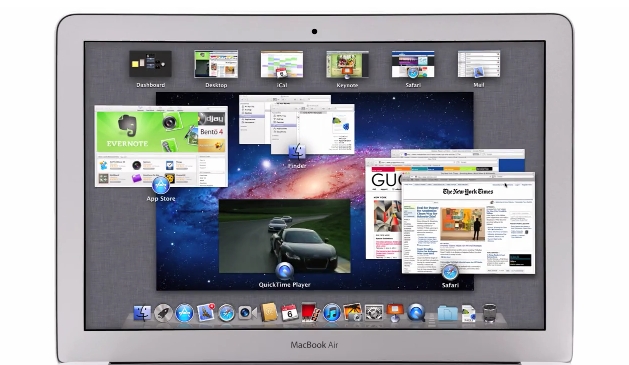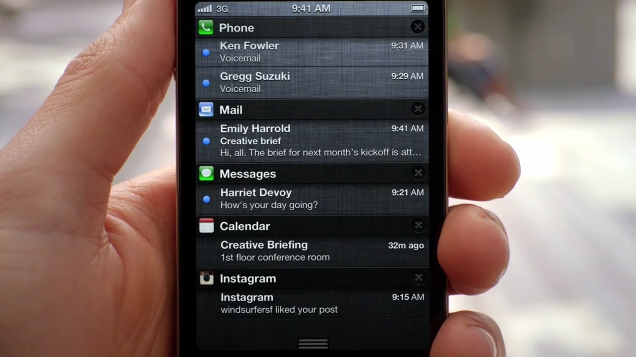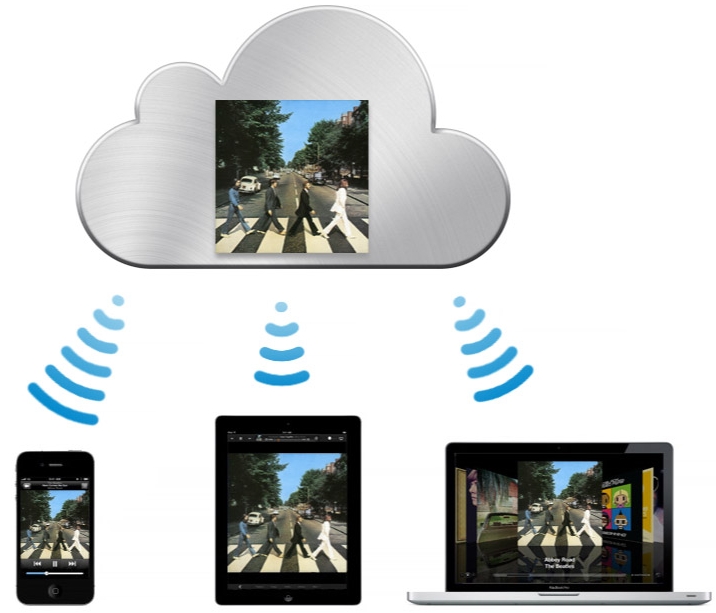
Today Apple brought the house down in San Fransisco’s Moscone Center where they previewed the latest versions of Mac OS X, iOS, and a new service called iCloud. Quote of the day comes from Apple CEO Steve Jobs who introduced the developer event with this: “If the hardware is the brain and the sinew of our products, the software in them is the soul.” The next-gen iPhone was nowhere to be found; today was all about the magical software that keeps Apple’s momentum chugging along at great pace. And now without further ado, let’s dive right in! It’s all after the break.

Lion
Mac OS X is about to see a major upgrade later this summer. Version 10.7 is Lion and it will bring over 250 new features to Apple computers and 3,000 new APIs for developers to take advantage of. During today’s event Apple highlighted ten key new features and they are…
(1) Multi-Touch Gestures: New gestures include momentum scrolling, tapping or pinching your fingers to zoom in on a web page or image, and swiping left or right to turn a page or switch between full screen apps.
(2) Full Screen Apps: With a single click your app fills the display and you can swipe from one window to another, between full screen apps, or back to your Desktop, Dashboard or Spaces without ever leaving full screen mode. Lion ships with system-wide support for full screen apps.
(3) Mission Control: This new view combines Exposé, full screen apps, Dashboard and Spaces into one unified experience for a bird’s eye view of every app and window running on your Mac. With a swipe, your desktop zooms out to display your open windows grouped by app, thumbnails of your full screen apps and your Dashboard, and allows you to instantly navigate anywhere with a tap.
(4) Mac App Store: It’s built into Lion and apps automatically install directly to Launchpad. It will be able to deliver smaller delta app updates and new apps can take advantage of In-App Purchase and Push Notifications.
(5) Launchpad: With a single multitouch gesture, all your Mac apps are displayed in a full screen layout. You can organize apps in any order or into folders and swipe through unlimited pages of apps to find the one you want, just like you can on your iOS devices.
(6) Resume: Lion can conveniently bring your apps back exactly how you left them when you restart your Mac or quit and relaunch an app.
(7) Auto Save: This feature will automatically and continuously save your documents as you work. Forgetting to save your work is a thing of the past.
(8) Versions: This feature automatically records the history of your document as you create it, and gives you an easy way to browse, revert and even copy and paste from previous versions. Browsing previous versions of a document uses the same timeline UI as Time Machine.
(9) Airdrop: Now it’s easy to transfer files from Mac to Mac; Airdrop finds nearby Macs and automatically sets up a peer-to-peer wireless connection to make transferring files super simple.
(10) Mail: The OS X mail app has been redesigned and now features a widescreen layout. The new Conversations feature groups related messages into an easily scrollable timeline, intelligently hiding repeated text so the conversation is easy to follow, and retaining graphics and attachments as they were originally sent. A new search feature allows you to refine your search and suggests matches by person, subject and label as you type. Also, Mail includes built-in support for Microsoft Exchange 2010.
For more on Lion, click here! It releases in July for $29.99, exclusively in the Mac App Store.

iOS 5
The next version of iOS will come packed with over 200 new features and 1,500 new APIs for developers to use. Again, ten key new features were explored in-depth at the event.
(1) Notification Center: Goodbye obtrusive notifications! Apple’s taken a page out of Android’s playbook here. When notifications arrive, they will appear briefly at the top of the screen without interrupting what you’re doing. With one swipe you can see all your notifications, and a simple tap will take you right to its app for more detail. You have the option to glance at weather updates and a stock ticker in the notifications window, too. Notifications also appear on the lock screen, with the ability to be taken to the notifying app with just one swipe.
(2) Newsstand: This is an easy-to-organize bookshelf displaying the covers of all your newspaper and magazine subscriptions in one place. It looks very similar to the bookshelf found inside iBooks. A new section of the App Store features just subscription titles. If subscribed to, new issues appear in the Newsstand and are updated automatically in the background so you always have the latest issue and the most recent cover art.
(3) Twitter: iOS 5 includes built-in Twitter integration, so you can sign in once under Settings and then tweet directly from all your Twitter-enabled apps, including Photos, Camera, Safari, YouTube and Maps with a single tap. New APIs give third party developers the ability to take advantage of the single sign-on capability for their own apps. Also, contacts can be attached to Twitter handles; Twitter profile pictures will show up in a contact’s card.
(4) Safari: New features include Safari Reader, which gets all the clutter out of the way and sets the right font size on a web page, so you can easily scroll and read through a story; Reading List, which allows you to save articles to read later and they automatically show up on all your iOS devices; and Tabbed Browsing, which makes it easy to flip between multiple web pages on iPad–it’s “lightening fast.”
(5) Reminders: The new Reminders app helps you manage your tasks; create and group related tasks together; and set time or location-based reminder alerts, priorities and due dates, so you can be reminded of a task as its deadline approaches, or when you arrive or depart a given location. Reminders can also be viewed in iCal and Outlook and are updated automatically.
(6) Camera: New features in the Camera and Photos apps give you instant access to the camera right from the lock screen, and finally there’s a physical button to snap a picture–the volume-up button does the trick. Optional grid lines help line up your shot and a simple tap locks focus and exposure on one subject. Lastly, the new Photos app lets you crop, rotate, enhance and remove red-eye, and organize your photos into albums right on your device to share them on the go.
(7) Mail: Enhancements to this app include the ability to compose messages using draggable addresses; new formatting bar with bold, italics, underline and indention controls; and now you can flag messages to mark them as unread and search the entire contents of messages. S/MIME is there are tighter security.
(8) PC Free: We live in a post-PC world according to Apple, so it’s time to cut the cord. iOS 5 users can activate and set up their iOS device right out of the box with no computer required, and iOS software updates are delivered over the air and installed with just a tap. Additionally you can now create and delete calendars and mailboxes right on the device.
(9) Game Center: New features include the ability to add photos to your profile, purchase new games from within the app, view friends of friends, and it’s easier to discover new friends and games. The same old boring UI is still there, unfortunately.
(10) iMessage: BBM, meet your match. iOS 5 brings the functionality of iPhone messaging to all iOS devices―iPhone, iPad and iPod touch. Built right into the Messages app, iMessage allows you to easily send text messages, photos, videos or contact information to a person or a group on other iOS 5 devices over WiFi or 3G. iMessages are automatically pushed to all iOS 5 devices. Example: If you start a conversation on your iPad, you can pick up from where you left off on your iPhone. Boom. iMessage also features delivery and read receipts, typing indication and secure end-to-end encryption. Supported over 3G and WiFi.
Other new features mentioned include… AirPlay Mirroring allows you to wirelessly display everything you do on your iPad 2 right on your HDTV through Apple TV; WiFi Sync securely and automatically backs up and syncs your devices content from your device to your iTunes library (more PC Free goodness!); new multitasking gestures; a system-wide split keyboard to makes it easier to type on the iPad; and a system-wide built-in dictionary (select a word and you’ll have the option to copy or define it).
iOS 5 ships this fall, and it’ll be compatible with the usual suspects–iPhone 4 and 3GS, iPad and iPad 2, and the third and fourth gen iPods touch.

iCloud
Jobs began the third and final arc of the event by telling a tale of the age-old problem: “Today it is a real hassle and very frustrating to keep all your information and content up-to-date across all your devices.” In Apple’s case, iTunes is king and in order to manage your content across all devices you’re forced to physically tether each device to your computer to initiate the back up and sync process. iCloud is about to change all that by making the computer (and iTunes) just another device. The cloud becomes king; it will store your content and wirelessly push it to all your devices wirelessly and automatically. “…and because it’s integrated into your apps you don’t even need to think about it–it all just works,” Jobs exclaimed.
MobileMe is dead. iCloud will take on the services it leaves behind and expands upon them greatly. The three core apps of MobileMe–namely Contacts, Calendar and Mail–have been completely re-architected and rewritten to work seamlessly with iCloud. It’s simple, really. If you add a new contact to your address book on your iPhone, the contact will be stored in the cloud and automatically push to all of your iOS devices. If you were to edit that contact on your iPad, the changes will automatically and wirelessly take effect across all of your iOS devices. The same goes for Calendar events and Mail. Calendars can be shared, new email messages, inboxes, and folders get pushed to all your devices and kept up-to-date. Also, all iCloud users are provided with an @me.com mail account.
In addition to the aforementioned core apps, iCloud introduces six more apps into the fold.
(1) App Store: In the App Store you’ll see a new Purchase History section that lists every app you’ve downloaded and installed. From there you can tap the iCloud icon and instantly you’re app(s) will fly to the cloud and shower down to the rest of your devices.
(2) iBookstore: See App Store…and you can push your bookmarks, too.
(3) iCloud Backup: This one’ll automatically and securely backs up your iOS device(s) to iCloud daily over WiFi when you chargin’ up. Backed up content includes purchased music, apps and books, Camera Roll (photos and videos), device settings, and app data. If you replace your iOS device or get a new one, just enter your Apple ID and password during setup and iCloud restores your new device with all your stuff!
(4) iCloud Storage: Seamlessly stores all documents created using iCloud Storage APIs (which Apple is providing devs today), and automatically pushes them to all your devices. iWork apps already have the API built-in. When you edit a document (Pages), presentation (Keynote), or spreadsheet (Numbers) on any device, iCloud automatically pushes the changes to all your devices.
(5) Photo Stream: This service automatically uploads the photos you take or import on any of your devices and wirelessly pushes them to all your devices and computers (Macs, Apple TV, and PCs included). Photo Stream is built into the photo apps on all iOS devices; they can be found in a folder with the same name and manually moved to local device storage to be kept forever if you like. On Macs they’re saved to iPhoto and to the My Pictures folder on PCs. More things to know… The last 1,000 photos are stored on each iOS device so they can be viewed or moved to an album to save forever. Macs and PCs will store all photos from the Photo Stream, since they have more storage. iCloud will store each photo in the cloud for 30 days, which Apple says is plenty of time to connect your devices to iCloud and automatically download the latest photos from Photo Stream via WiFi.
(6) iTunes in the Cloud: It’s the service we’ve all been waiting for. iTunes in the Cloud lets you push all your previously purchased iTunes music to all your iOS devices at no additional cost, and new music purchases can be downloaded automatically to all your devices. Just like in the App Store, the iPod app will feature a new Purchased section that shows you your entire music purchase history. Find a song, tap the iCloud icon, and it will be pushed to all your devices. When you purchase a new song or album on a device it will automatically push to all devices, no manual syncing (read: tapping the iCloud icon) required. Now what happens to the songs that you haven’t purchased from the iTunes Store, ones you’ve ripped off CDs perhaps? That’s where iTunes Match comes in. For $29.99/year this service will replace your ripped music with a 256 kbps AAC DRM-free version if Apple can match it to the over 18 million songs in the iTunes Store. Matched music becomes available in minutes (instead of weeks to upload your entire music library, like Google’s Music Beta). A “small percentage” of unmatched music can be uploaded, too.
So that’s iCloud. Pretty neat, eh? And aside from the optional iTunes Match service, it’s all FREE. To sign up for iCloud all you have to do is input your Apple ID and password on an iOS 5 device. That’s right–iCloud will formally release alongside iOS 5 this fall. Everyone get 5GB of storage for Mail, Document Storage and Backup; and get this–the storage for music, apps and books purchased from Apple and the storage required by Photo Stream doesn’t count towards this total. Boom shaka laka.
Try out a small slice of iCloud today. iTunes in the Cloud is available now (in beta form) in the US and requires iTunes 10.3 and iOS 4.3.3. Also, automatic download of apps and books is available today.
Aaand I’m spent…and you should be, too. What a jam-packed WWDC!
[Via Apple]